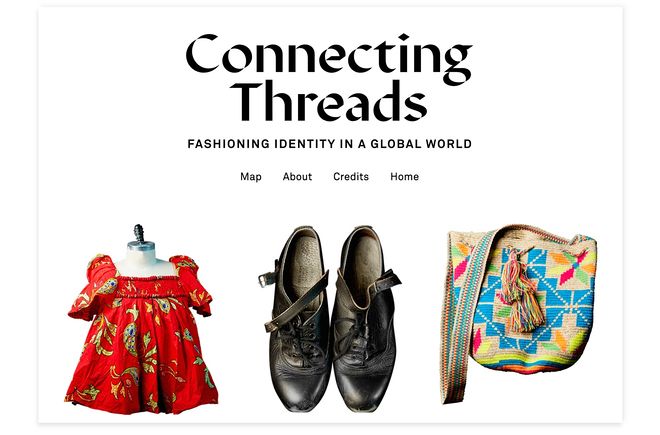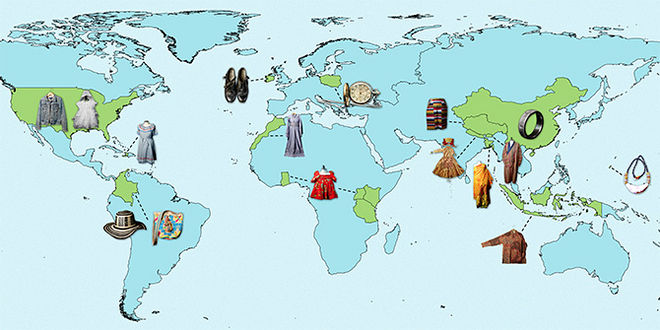
Click to view website.
A hand-carved Sinahi necklace from the island of Guahan (Babauta). The stone-encrusted crown, shining ornaments and traditional dress comprising a costume for the “Living Goddess” Kumari from Kathmandu, Nepal. A vividly colored, boldly patterned crocheted bag from La Guajira, Colombia. A faded and fraying example of the classic American denim jacket.
These are only a handful of examples from the extraordinary collection of objects that was unveiled on June 2 during the virtual opening for the online exhibition Connecting Threads: Fashioning Identity in a Global World. This ambitious exhibition marks the culmination of a year-long collaboration between the Bard Graduate Center and CUNY LaGuardia Community College in Long Island City. Set in motion thanks to the valuable leadership and support of Lisa Selz, the partnership reflects the BGC’s continued efforts to promote diversity, equity and inclusion in the field of decorative arts, design history and material culture. “Connecting Threads is a wonderful example of the power of collaboration—among students and faculty, as well as between LaGuardia Community College and Bard Graduate Center—to create something truly new and exciting,” says Dr. Paul Arcario, LaGuardia’s interim president. “With guidance and support from faculty and staff at both LaGuardia and BGC, our students have opened their closets, giving us a glimpse of not just their wardrobes, but of the experiences, relationships, hopes, and dreams that connect them to their clothing as well.”
As its title suggests, connectivity has been a central theme throughout the exhibition’s formulation and planning process. The sixteen objects of fashion and adornment on view were selected by cultural anthropology students from LaGuardia as part of a course taught by associate professor Filip Stabrowski in the fall of 2019. Initially chosen for reasons of personal resonance, the objects were then studied in greater depth as students explored the broader contexts of their production, consumption and use in an increasingly globalized world. Class visits from BGC faculty members Catherine Whalen and Ivan Gaskell helped the students hone their research, which was then shared with another group of LaGuardia students the following semester. The participants in assistant professor Liena Vayzman’s spring 2020 course on art and society were tasked with interpreting and presenting their peers’ work through the creation of a cohesive and accessible public exhibition, which was to be held in the fourth-floor space of the BGC’s gallery at 18 West 86th Street.
Then, of course, COVID-19 happened. But rather than call off the exhibition entirely, the BGC’s Director of Public Engagement Emily Reilly proposed pivoting to a digital exhibition. The idea was met with enthusiasm by the class professors and the LaGuardia archives department, and things began to move quickly, with the archives department rushing to organize professional photography of each object with only a day to spare before the shelter-in-place order was issued. On the BGC’s end, Reilly enlisted the aid of colleagues Jocelyn Lau, Designer; Hellyn Teng, Web Manager; and Jesse Merandy, the Director of the Digital Media Lab, as well as BGC MA student Juliana Fagua Arias (’21), to make the transition online. Plans to host the LaGuardia students for an installation workshop in the gallery space turned into virtual sessions held by BGC staff to introduce students to the vocabulary and possibilities of digital humanities and discuss different design and formatting options for online exhibitions. In spite of these changes, the students remained actively engaged with the development of the exhibition, voicing ideas and feedback on matters from the website’s overall layout to concerns over the site’s legibility for users with dyslexia or colorblindness. “It surprised me how involved the students wanted to be, and the great input they gave me,” said Lau, who met with the students over Zoom several times and was impressed by the thoughtfulness and inclusiveness of their comments.
Beyond issues relating to the site’s design, the students were equally responsible for the interpretative aspects of the exhibition, composing brief introductory texts for each of the featured objects in accordance with gallery text standards. In addition to these descriptive labels, many students have taken advantage of the exhibition’s digital platform by incorporating short films or audio files on their pages to provide additional cultural context or illustrate a similar type of object in active use. For Reilly, the students’ multimedia additions were a positive aspect of the shift to a virtual exhibition space. “The digital realm has allowed them to explore more associative curatorial thinking, and other ways we can use media to situate an object in its context,” she says, something that wouldn’t have been possible to this degree within the confines of the physical gallery space. Some students have also used the expanded space of the online exhibition to include translations of their exhibition texts to non-English languages, including Spanish, Bengali and Pidgin. As Vayzman noted at the virtual opening, these efforts reflect LaGuardia’s emphasis on language equity, underlining the school’s message that “all languages are valid in education.” The relocation of the exhibition to the virtual realm also presented the opportunity to publish the first-semester students’ object essays on the site, further connecting the two groups of students and broadening the perspectives offered on each object.

The students’ objects in Connecting Threads found their way to New York from over a dozen countries.
However, as Reilly points out, the move online has had drawbacks as well. “What saddens me a little bit is that this second group of students never got to touch the objects they were working on,” she says. Workshops planned by the BGC for the students were intended to encourage tactile engagement and address the material requirements for the safe installation of each object, but these had to be canceled with the arrival of the shelter-in-place order. Given the significance of close looking to the BGC’s approach to material culture studies, Reilly notes that providing opportunities for students to handle and take in the details of their objects would be a priority for any future iterations of this project, even if the exhibition they create is ultimately web-based.
Despite the students’ lack of access to the objects this time, the development of the digital exhibition over the past year has been a tremendous success, and one that carries heightened significance in this moment of global crisis. While the need for physical separation in the wake of the pandemic prompted the exhibition’s move online, the exhibition’s opening took place amidst the swell of public outcry for racial justice following the killings of George Floyd, Breonna Taylor, Ahmaud Arbery, and so many others, adding another dimension to the importance of its message of connectivity. Indeed, Reilly consulted with the LaGuardia students and faculty the morning of the opening to ask if they wanted to postpone the event in respect for Blackout Tuesday, a call that originated in the music industry for individuals and businesses to take a pause from business as usual and reflect upon the systemic racism and injustice that perpetuates violence against Black and Brown people.
Ultimately, though, the students and faculty wanted to continue with the event, “in a spirit of unity and solidarity,” with faculty members stressing how the exhibition “celebrates the human connections that forge our identities and bring us together.” “It’s a ray of sunshine,” remarked Vayzman in the last few moments of the exhibition’s opening, noting how the students’ collaborative scholarship on these richly diverse objects reveals “our shared connections, shared responsibilities, and shared future.” The process of the exhibition’s creation, and the resilience of everyone involved at the BGC and LaGuardia as it shifted to the digital, has strung new threads between our two institutions and communities. In the words of LaGuardia student Samantha Brown, “finding our connections is of the utmost importance right now,” and Connecting Threads has been “a way to look at something positive about our humanity, and how we are all connected.”
– Elizabeth Koehn
Elizabeth Koehn received her MA from Bard Graduate Center in 2020.
